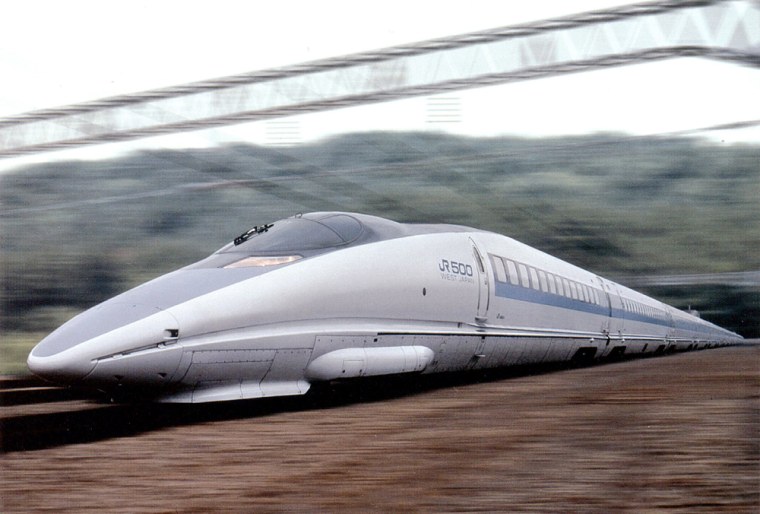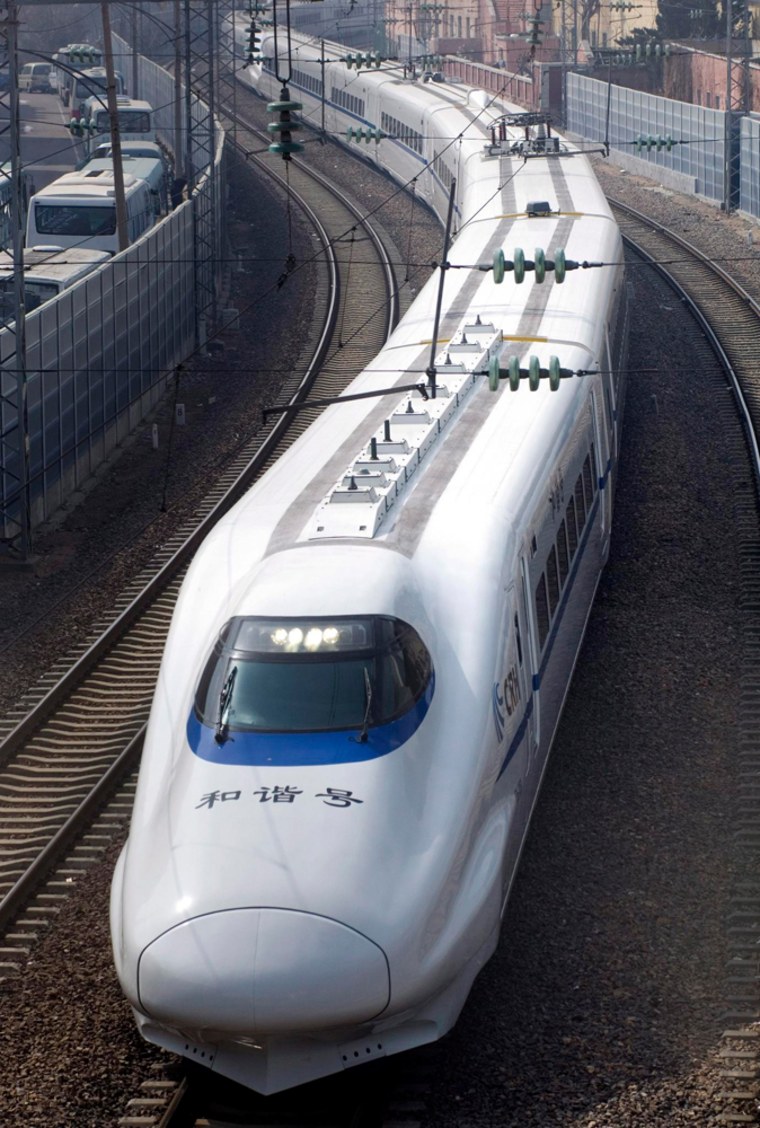To Americans, high-speed trains evoke the gee-whiz factor of a trip to Tomorrowland: Ride futuristic cars that zoom you to a destination in a fraction of the drive time — without having to fight your way through an airport. Read a book, do paperwork, take a nap while you whoosh ahead in high-speed comfort.
To governments, they evoke benefits to the common good — reduced freeway traffic, lower carbon pollution and more jobs.
But this country has never built a high-speed "bullet" train rivaling the successful systems of Europe and Asia, where passenger railcars have blurred by at top speeds nearing 200 mph for decades.
Since the 1980s, every state effort to reproduce such service has failed. The reasons often boil down to poor planning and simple mathematics.
Billions for rail in stimulus plan
Yet President Barack Obama, intent on harnessing new technology to rebuild the devastated economy, made a last-minute allocation of $8 billion for high-speed rail in his mammoth stimulus plan.
It sounds good, but that amount isn't enough to build a single system, or to dramatically increase existing train speeds, transportation experts say.
California is the only state with an active project, and its proposed cost is more than five times the stimulus amount. The $42 billion plan is far from shovel ready — it's still seeking local approvals — but it's farther down the track than any other state with an outstretched hand for a slice of Obama's high-speed pie.
There are rail advocates who say anything is better than nothing when it comes to modernizing U.S. train transportation, which needs all the help it can get. Others say the stimulus injection is like adding a teaspoon of water to the ocean and calling it high tide.
Six proposed routes
Roughly six proposed routes with federal approval for high-speed rail stand a good chance of getting some of the $8 billion award, according to U.S. Transportation Department officials. The spurs include parts of Texas, Florida, the Chicago region, and southeast routes through North Carolina and Louisiana.
Officials in those areas have said they'd be happy to take part of the president's offer, even though they don't have high-speed systems to pump money into. Talking with reporters recently, Obama said he'd love to see such trains in his former state of Illinois linking Chicago to Wisconsin, Missouri and Michigan.
The economic benefit is enormous, the president said. "Railroads were always the pride of America, and stitched us together. Now Japan, China, all of Europe have high-speed rail systems that put ours to shame."
New Transportation Secretary Ray LaHood, a former Republican congressman also from Illinois, said developing high-speed rail is the country's No. 1 transportation priority.
"Anybody who has ever traveled in Europe or Japan knows that high-speed rail works and that it's very effective," LaHood said in an interview with The Associated Press.
What exactly is "high-speed"? It depends on the location. The U.S. Federal Railroad Administration says the term applies to trains traveling more than 90 mph. The European Union standard is above 125 mph.
Super-fast trains run across the world
And many overseas bullet trains — most powered by overhead electricity lines — run faster than that. In France, for example, the TGV ("Train a Grande Vitesse") covers the 250 miles between Paris and Lyon in one hour, 55 minutes at an average speed of about 133 mph. A 25,000-horsepower French train reached 357.2 mph in 2007, setting a world record for conventional train systems.
In Japan, which opened the first high-speed rail in the 1960s and carries more passengers than any other country, Shinkansen trains hurtle the countryside at an average of about 180 mph. Japan's magnetically levitated train — different from conventional wheels-on-rails technology — holds the overall world speed record at 361 mph.
Super-fast trains also run in Germany, Spain and China, at speeds up to 140 mph, according to a 2007 survey in the trade publication Railway Gazette.
Amtrak's Acela Express route
The only rail service that qualifies under America's lower high-speed standard is Amtrak's 9-year-old Acela Express route connecting Boston to Washington, D.C.
The trains are built to reach speeds up to 150 mph, but only average about 80 mph because of curving tracks and slower-moving freight and passenger trains that share the route. On the densely traveled line from New York City to the nation's capital, the Acela arrives just about 20 minutes earlier than standard service, at more than twice the cost during peak travel times.
For instance, a one-way Acela fare leaving New York at 11 a.m. is $155. The same departure on a regular train costs $72.
"In virtually no way does the Acela Express perform near overseas standards," says author Joseph Vranich, a former Amtrak public affairs spokesman and president of the High Speed Rail Association. In 2004 he wrote a highly critical book titled, "End of the Line: The Failure of Amtrak Reform and the Future of America's Passenger Trains."
Unimpressed with stimulus money
He's equally unimpressed with the federal stimulus money.
"Here's what's going to happen: The (Obama) administration will issue these funds in dribs and drabs — to this project and that project — and the result will be an Amtrak train from Chicago to St. Louis that takes maybe 15 minutes off the travel time."
Current Amtrak travel time between the two cities is about five hours, 30 minutes.
Trying to make American trains run faster will always go off the rails, Vranich says, as long as planners keep trying to recreate overseas systems. "We're not Europe. We're not Japan. We're looking at shorter travel times, through population densities that are much higher."
In other words, plans to put a screaming bullet train through American towns with concentrated populations will always face hard challenges.
Which is part of the reason previous efforts failed in Florida, Texas and Southern California.
In 2000, development of a Florida high-speed rail service was approved by voters. Four years later, concerns about community impact and construction costs estimated at $20 billion to $25 billion drove voters to repeal it, ending plans for a Tampa-St. Petersburg-Orlando system, as well as a proposed second link from Orlando to Miami.
Texas consortium canceled project
Still, the state has high-speed rail enthusiasts who want to tap Obama's $8 billion to resurrect the transit idea, including proposed routes that could include a link between Walt Disney World and Orlando International Airport.

In the 1990s, Texas awarded a 50-year high-speed rail franchise to an international consortium that claimed it could connect the "Texas Triangle" — Dallas, Houston and San Antonio — with a $5.6 billion rail system financed entirely with private funds.
Four years later, Texas canceled the project after cost estimates rose to $6.8 billion and the consortium failed to meet state deadlines. Bullet train plans have languished since then, though a grass-roots organization was formed in 2002 to bring fast rail service to Texas. Some die-hard supporters hope getting a piece of the stimulus money would reawaken high-speed rail desires. But many farmers and landowners along proposed routes fear losing their property to eminent domain.
California has one of the country's most tortured relationships with bullet trains.
In 1982, a hastily written $2 billion bullet train bill sailed through the closing days of the legislative session and was signed by then-Gov. Jerry Brown, a longtime cheerleader for fast rail. The measure specifically exempted the project from the state's strict environmental review process and allowed California to underwrite tax-exempt revenue bonds to help fund the 125-mile route between San Diego and Los Angeles that bragged of nonstop, 59-minute train service.
Project scrapped over protests
The system was never built. Led by a private company that included two former Amtrak officials, the project was ultimately abandoned for several reasons, including a barrage of protests from residents near proposed stations and public outcry over exempting it from environmental review.
Fourteen years later, the state legislature formed the California High Speed Rail Authority, charged with planning and developing fast trains between metropolitan areas in the most populous, and arguably car-conscious state.
After two failed attempts to make the ballot, a $9.95 billion bond measure was approved by voters in November to help fund the first leg of what would ultimately be an 800-mile system — service between San Francisco and Anaheim, home to Disneyland — at a promised travel time of 2 1/2 hours.
The newest plan also faces criticism. Opponents doubt the wisdom of building a gargantuan project that won't move a train for at least 10 years, while California proposes cutting services and raising taxes during a national economic meltdown.
No bonds have been sold yet. The authority is running out of money. In early March, officials said engineering work may stop unless the state lends it nearly $30 million. Critics also question the authority's ability to get at least $6.5 billion from private investors in this reeling financial market.
Some rail supporters encouraged
Quentin Kopp, a former state senator and longtime rail supporter, chairs the authority. He wants at least $2 billion of the federal stimulus money and just returned from a trip to Washington where he lobbied transportation officials and Congress members including Democratic House Speaker Nancy Pelosi, a high-speed supporter who's also from San Francisco.
"It was very encouraging," said Kopp.
Yet other rail activists look at the stimulus money and see no bullet trains at all.
Ross Capon of the National Association of Railroad Passengers, an advocacy group for rail travel, is a member of the anything-is-better-than-nothing group when it comes to improving train service.
He's also blunt in describing America's inability to make speedy tracks. "The reason why high-speed rail has never taken off is because this country is determined to live on cheap gasoline and airplane travel," he said.
And to his way of thinking, that means Obama's infusion will probably go toward fixing what the country already has.
"It's very likely that all of the money will go to significant improvements of existing tracks. It's not going to build bullet trains," Capon said.
